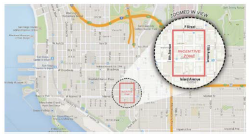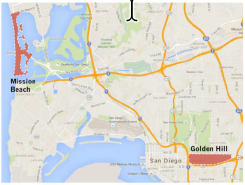Expanding Traveler Choices through the Use of Incentives: A Compendium of Examples2. Applying Incentives to Modify Travel RoutesRebalancing Shared Electric Vehicles in San DiegoINCENTIVE SUMMARY
TYPE: STUDY
CURRENTLY: INACTIVE STARTED IN: 2014 INCENTIVE(S) APPLIED:
As part of the Federal Highway Administration Value Pricing Pilot grant program, researchers conducted a 2-year evaluation of incentives applied to a one-way, all electric car-sharing system that was measured using the car2go San Diego market. The evaluation began in 2014, and shortly after it ended, car2go left the San Diego market due to lack of demand. The goal of the incentive program was to redistribute electric vehicles available through the car2go car-sharing program, increasing access for users of the car2go system, and decreasing travel time for the car2go maintenance team, which was responsible for keeping the electric vehicle fleet charged.  a) Charging area incentive zone  b) Low demand incentive zone.
b) Low demand incentive zone.
Figure 2. Maps. Compound figure depicts the car2go incentive zones in San Diego. Car2go, a subsidiary of Daimler North America Corporation, is a car-sharing service with its North American headquarters in Austin, Texas. Fees are based on how long a driver uses the car rather than by how far they travel. The system allows users to rent cars through a cell phone app, enabling them to pick up and drop off the car in different locations as opposed to the usual round-trip car-sharing experience. The incentive program was available to all car2go users across San Diego, as the entire fleet of car2go Smart Cars in this city were electric. Users could take part in either of two incentives to help car2go reach its goal. The first incentive helped achieve the goal of moving cars closer to the charging area, decreasing travel time by car2go employees to bring in cars for charging. Drivers were eligible after driving a minimum of 15 minutes and parking the vehicle within a three-block by three-block zone (see figure 2a). The second incentive aimed to prevent an over- supply of cars in low-demand zones. In order to be eligible for this incentive, users would drive a car starting within two predefined regions for at least 10 minutes and park the car outside of those zones (see figure 2b). In both incentive scenarios, users received a 10-minute driving credit to their account in the car2go application. Throughout the incentive program, surveys were sent to participants to measure how they used car2go and what their motivation for participating in the different incentives might be. The surveys found that participants most often used the service for recreational activities. Increased use of car2go resulted in some respondents reporting a change in their use of public transportation, taxis, and walking. One finding that was of interest to the research team was that respondents reported using ride-sourcing options, such as Lyft or Uber, more often. A possible explanation was that users might drive themselves via car2go to bars and restaurants, but take a ride-source option home to avoid drinking and driving. When participants who were aware of the incentive but had not yet taken advantage of it were asked why they had not done so, responses generally indicated that the users' final destinations were not within the drop-off zones, and many believed they would use the incentive in the future. Thirty percent of all respondents to this survey reported vehicles having more of a charge than before. (Shaheen et al., 2018) Respondents indicated that incentives in the form of driving minutes credited to their account were more valuable than the cash value.
After the incentive period had ended, surveys were sent out to query car2go users about how they might use these incentives in the future. Respondents indicated that incentives in the form of driving minutes credited to their account were more valuable than the cash value. When a hypothetical offer was made for the cash equivalent, users replied that they would be less likely to drive a vehicle to a charging zone. For more information, see One-way Electric Vehicle Carsharing in San Diego: An Exploration of Behavioral Impacts and the Impact of Pricing Incentives on Improving Operational Efficiency by Susan A. Shaheen, Ph.D, Elliot Martin, Ph.D, and Apaar Bansal. Available at: http://www.dot.ca.gov/newtech/researchreports/reports/2018/CA18-2499_FinalReport.pdf. You may need the Adobe® Reader® to view the PDFs on this page. |
|
United States Department of Transportation - Federal Highway Administration |
||